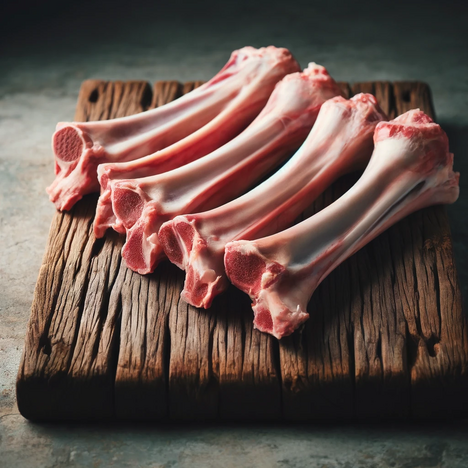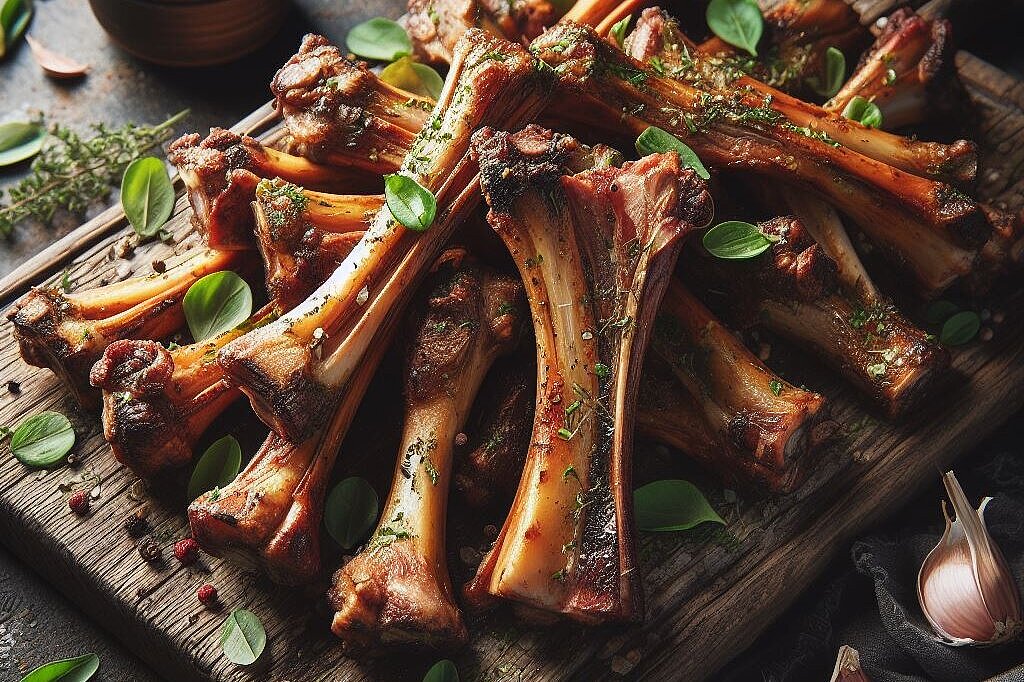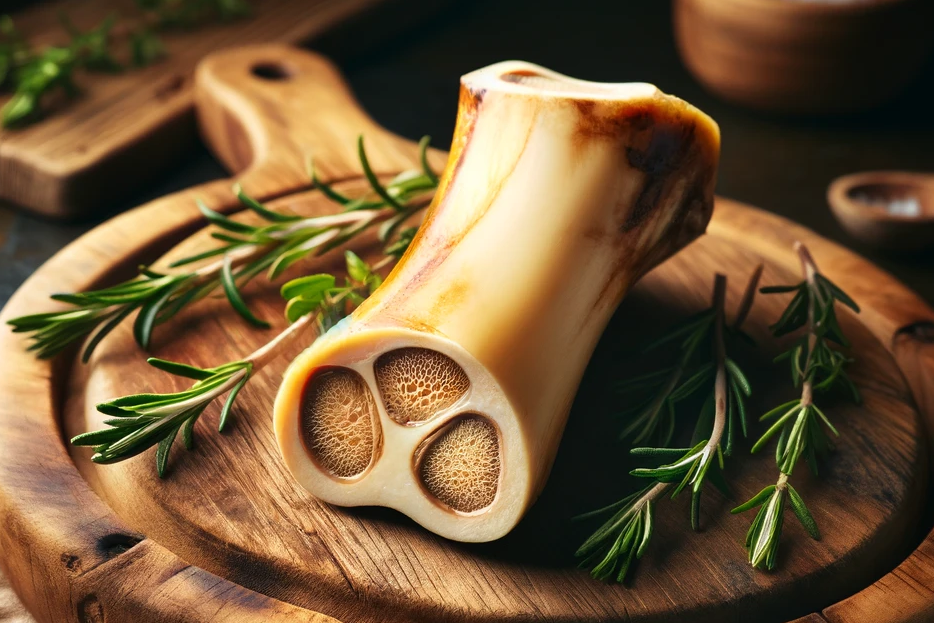Lamb bone

Lamb bones are a tasty and healthy snack for many dogs. Not only do they provide long-lasting chewing pleasure, they also have many benefits for your four-legged friend's health and well-being. In this article, you'll find out everything you need to know about lamb bone for dogs: what is lamb bone, what are its advantages and disadvantages, how often and how much can you give it to your dog and what should you look out for when feeding it?
What is lamb bone?
Lamb bones are the bones of young sheep that are less than one year old. They are usually smaller and softer than the bones of older sheep or other animals such as cattle or pigs. Lamb bones consist of a hard outer part, the bone substance, and a soft inner part, the bone marrow. There is often some meat, fat or cartilage still attached to the bones.
What are the benefits of lamb bone for dogs?
Lamb bones for dogs have many benefits, both for your dog's physical and mental health. Here are some of them:
- Lamb bones provide your dog with valuable minerals. Calcium is particularly worth mentioning in this context, as it is essential for strong bones and teeth. The tasty chewy product also contains phosphorus, magnesium and zinc, which are also important for the metabolism and immune system.
- Lamb bones are hypoallergenic. This means that they rarely trigger allergic reactions. Lamb is also suitable for dogs that are allergic to beef or poultry or have a sensitive digestive system.
- Lamb bones promote dental hygiene. By chewing on lamb bones, dogs can clean their teeth and reduce plaque. This prevents tartar, bad breath and inflammation of the gums.
- Lamb bones satisfy the natural urge to chew. Dogs naturally have a strong urge to chew. This helps them to relieve stress, avoid boredom and strengthen their chewing muscles. Lamb bones offer your dog a meaningful activity and a reward for good behavior.
What are the disadvantages of lamb bones for dogs?
Lamb bones for dogs also have some disadvantages that you should be aware of. Here are some of them:
- Lamb bones can splinter. Although lamb bones are less brittle than other animal bones, they can still splinter, especially when cooked or dried. Splinters can get stuck in your dog's mouth or digestive tract or cause injury.
- Lamb bones can lead to constipation. Too many bones can make your dog's stool hard and dry, which can lead to difficulty defecating. In the worst case, this can lead to a life-threatening intestinal blockage.
- Lamb bones can lead to obesity. Lamb bones contain a lot of fat and calories, which can be noticeable on your dog's hips if eaten in excess. Obesity can lead to many health problems such as diabetes or joint disease.
How often and how much lamb bone can I give my dog?
Lamb bones are a great addition to your dog's diet, but they should not be the main source of nutrition. As a rule of thumb, you shouldn't give your dog lamb bones more than once or twice a week. The amount will depend on your dog's size and weight, but usually one small to medium sized lamb bone per feeding is sufficient. You should also make sure that you adjust the total amount of food when giving your dog lamb bones to avoid overfeeding.
What should I pay attention to when feeding lamb bones?
To make feeding lamb bones safe and enjoyable for your dog, you should follow these tips:
- Only feed raw or fresh lamb bones. Avoid boiled, roasted or grilled bones at all costs, as these can splinter more easily and cause injuries. In addition, many nutrients are lost through heating.
- Choosethe right size and shape for your dog. Bones that are too small or too thin can be swallowed by your dog or get stuck in their throat. Bones that are too large or too thick can lead to broken teeth or jaw injuries. Lamb bones with meat content, such as lamb ribs or lamb feet, are best.
- Supervise your dog when chewing. Even if your dog is an experienced bone nibbler, you should not let him out of your sight when he gets a lamb bone. This way you can intervene quickly if something goes wrong or your dog chokes.
- Always have fresh water available. Chewing is tiring and makes your dog thirsty. Your dog should always have access to clean water to quench his thirst and rinse his mouth.
- Dispose of leftovers properly. If your dog hasn't eaten all of his lamb bone, you should dispose of the leftovers or store them in the fridge. Don't leave them for too long as they may spoil or grow mold.
Lamb bones for dogs are a tasty and healthy addition to your four-legged friend's diet. They offer many benefits for your dog's health and well-being, such as providing minerals, promoting dental hygiene and satisfying their natural urge to chew. However, you should be aware of some disadvantages and risks, such as bone splitting, constipation or obesity. To make feeding lamb bones safe and enjoyable for your dog, you should only feed raw or fresh bones, choose the right size and shape for your dog, supervise your dog while chewing, always provide fresh water and dispose of leftovers properly. If you follow these tips, you can give your dog a lamb bone as a snack or reward once or twice a week.
If you notice any signs of hypersensitivity or poisoning in your dog, you should see your vet immediately. We are not a substitute for a vet, but we try to be as accurate as possible. Every dog reacts differently and we recommend you get a second opinion or consult your vet if in doubt.
Stay healthy and take good care of your four-legged friend!😊
Similar to Lamb bone
Pork bones are, as the name suggests, bones from pigs. They are rich in minerals such as calcium and phosphorus, as well as cartilage, connective tissue and fat. Most pork bones are sold raw and can...
Goat bones are a product from the slaughter of goats. These are the bones and cartilage that are not suitable for human consumption. These are dried, crushed and processed into a powder or...
Cattle bones are the bones of cattle, which are usually a waste product of meat processing. They can come from various parts of the cow, such as the sternum, ribs, joints or tail. In addition to...
Bone marrow is the soft tissue found inside the bones. It consists of two types: red bone marrow, which is responsible for the production of blood cells, and yellow bone marrow, which mainly...



